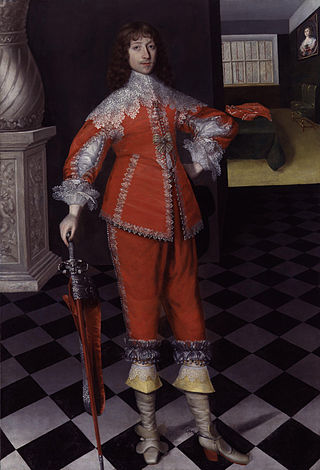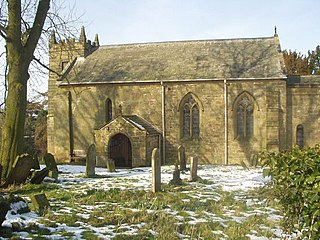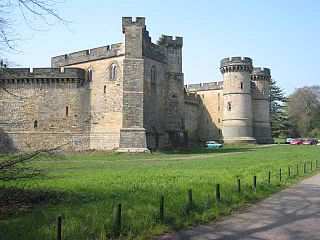
Henry Lascelles, 2nd Earl of Harewood DL, known as Viscount Lascelles from 1814 to 1820, was a British peer, Tory politician, planter and art collector.

William Saunders Sebright Lascelles PC was a British Whig politician. He served as Comptroller of the Household from 1847 to 1851.

John Belasyse, 1st Baron Belasyse was an English nobleman, Royalist officer and Member of Parliament, notable for his role during and after the Civil War. He suffered a long spell of imprisonment during the Popish Plot, although he was never brought to trial. From 1671 until his death he lived in Whitton, near Twickenham in Middlesex. Samuel Pepys was impressed by his collection of paintings, which has long since disappeared.
This is a list of people who have served as Lord Lieutenant for the East Riding of Yorkshire. The office was established after the English Restoration in 1660, when a Lord Lieutenant was appointed for each Riding of Yorkshire. Since 1721, all Lord Lieutenants have also been Custos Rotulorum of the East Riding of Yorkshire, and for part of the period also Lieutenants of the Town and County of the Town of Kingston upon Hull. It was abolished on 31 March 1974 with the creation of the county of Humberside, but was re-created upon the abolition of Humberside on 1 April 1996.
The post of Lord Lieutenant of the North Riding of Yorkshire was created in 1660, at the Restoration. It was abolished on 31 March 1974, and replaced with the office of Lord Lieutenant of North Yorkshire. From 1782 until 1974, all Lords Lieutenant were also Custos Rotulorum of the North Riding of Yorkshire.
Bedfordshire was a United Kingdom Parliamentary constituency, which elected two Members of Parliament to the House of Commons of England from 1295 until 1707, then the House of Commons of Great Britain until 1801 and the House of Commons of the United Kingdom until 1885 when it was divided into two constituencies under the Redistribution of Seats Act 1885.
Malton, also called New Malton, was a constituency of the House of Commons of the Parliament of England in 1295 and 1298, and again from 1640, then of the Parliament of Great Britain from 1707 to 1800 and of the Parliament of the United Kingdom from 1801 to 1885. It was represented by two Members of Parliament until 1868, among them the political philosopher Edmund Burke, and by one member from 1868 to 1885.

The East Riding of Yorkshire was a parliamentary constituency covering the East Riding of Yorkshire, omitting Beverley residents save a small minority of Beverley residents who also qualified on property grounds to vote in the county seat. It returned two Members of Parliament to the House of Commons of the Parliament of the United Kingdom. A brief earlier guise of the seat covered the changed franchise of the First Protectorate Parliament and Second Protectorate Parliament during a fraction of the twenty years of England and Wales existed as a republic.
Knaresborough was a parliamentary constituency which returned two Members of Parliament (MPs) to the Parliament of England, Parliament of Great Britain and the House of Commons of the Parliament of the United Kingdom until 1868, and then one MP until its abolition in 1885.

Walter Strickland was an English politician and diplomat who held high office during the Protectorate.

Sir George Strickland, 7th Baronet, also known as Sir George Cholmley was an English Member of Parliament and lawyer. He took the name Cholmley to succeed to the Cholmley estates in 1865.
Surrey was a constituency of the House of Commons of the Parliament of England, then of the Parliament of Great Britain from 1707 to 1800 and of the Parliament of the United Kingdom from 1801 to 1832. It was represented by two Members of Parliament until 1832.

Henry Meysey Meysey-Thompson, 1st Baron Knaresborough was a Liberal politician who sat in the House of Commons variously between 1880 and 1905 when he was raised to the peerage as Baron Knaresborough.

Francis Lascelles (1612-1667), also spelt Lassels, was an English politician, soldier and businessman who fought for Parliament in the 1639-1652 Wars of the Three Kingdoms and was a Member of Parliament between 1645 and 1660.
Thomas Belasyse, 1st Viscount Fauconberg, styled Baron Fauconberg between 1627 and 1643 and Sir Thomas Belasyse, 2nd Baronet between 1624 and 1627, was an English politician who sat in the House of Commons at various times between 1597 and 1624 and was raised to the peerage in 1627. He was an ardent supporter of the Royalist cause in the English Civil War.

The Honourable Henry Belasyse, or Bellasis, May 1604 to May 1647, was an English politician from Yorkshire who sat in the House of Commons of England variously between 1625 and 1642.

The Palmes family of Naburn Hall, and the cadet branches of Lindley Hall, North Yorkshire; Ashwell, Rutland; and Carcraig in Ireland, are an ancient English aristocratic family, noted for their adherence to Catholicism.

Sir Henry Belasyse, also spelt Bellasis, was an English military officer from County Durham, who also sat as MP for a number of constituencies between 1695 and 1715.
William Eure, 4th Baron Eure was an English nobleman.











